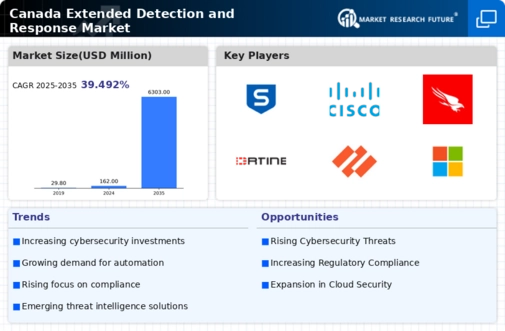Rising Cyber Threats
The increasing frequency and sophistication of cyber threats in Canada is a primary driver for the extended detection-response market. Organizations are facing a surge in ransomware attacks, phishing schemes, and data breaches, which necessitate advanced security measures. In 2025, it is estimated that cybercrime could cost Canadian businesses over $10 billion annually. This alarming trend compels companies to invest in extended detection-response solutions to enhance their security posture. The extended detection-response market is thus witnessing heightened demand as organizations seek to mitigate risks and protect sensitive data. As cyber threats evolve, the need for comprehensive detection and response capabilities becomes more critical, driving growth in this sector.
Increased Regulatory Pressures
The extended detection-response market is significantly influenced by the growing regulatory landscape in Canada. With the introduction of stringent data protection laws, such as the Personal Information Protection and Electronic Documents Act (PIPEDA), organizations are compelled to adopt robust security measures. Compliance with these regulations is not only a legal obligation but also a means to build trust with customers. In 2025, it is projected that compliance-related expenditures could account for up to 15% of IT budgets in Canada. This regulatory pressure drives the demand for extended detection-response solutions, as organizations seek to ensure compliance while effectively managing security risks. The extended detection-response market is thus positioned to benefit from this trend, as companies prioritize investments in security technologies.
Growing Adoption of Remote Work
The shift towards remote work in Canada has created new security challenges, thereby propelling the extended detection-response market. As organizations embrace flexible work arrangements, the attack surface expands, making it imperative to secure remote endpoints. In 2025, it is estimated that over 30% of the Canadian workforce will continue to work remotely, necessitating enhanced security measures. The extended detection-response market is responding to this trend by offering solutions that provide visibility and control over remote devices. This shift not only increases the demand for advanced security solutions but also highlights the need for integrated approaches to threat detection and response, further driving market growth.
Increased Awareness of Cybersecurity Risks
There is a growing awareness of cybersecurity risks among Canadian businesses, which is significantly impacting the extended detection-response market. As high-profile data breaches make headlines, organizations are becoming more cognizant of the potential repercussions of inadequate security measures. In 2025, surveys indicate that over 70% of Canadian companies view cybersecurity as a top priority. This heightened awareness is driving investments in extended detection-response solutions, as businesses recognize the need for comprehensive security strategies. The extended detection-response market is thus experiencing growth as organizations strive to protect their assets and maintain customer trust in an increasingly digital landscape.
Technological Advancements in Security Solutions
Technological innovations are reshaping the extended detection-response market in Canada. The emergence of advanced analytics, machine learning, and artificial intelligence is enabling organizations to enhance their threat detection and response capabilities. In 2025, it is anticipated that investments in AI-driven security solutions will increase by 25%, reflecting a growing recognition of their effectiveness. The extended detection-response market is benefiting from these advancements, as organizations seek to leverage technology to improve their security posture. This trend indicates a shift towards proactive security measures, where organizations can anticipate and mitigate threats before they escalate, thereby driving demand for sophisticated detection-response solutions.




















Leave a Comment